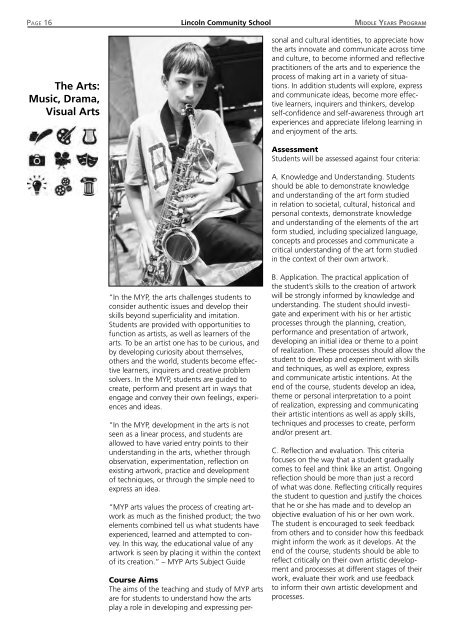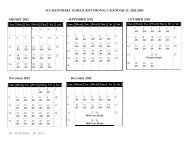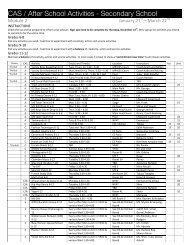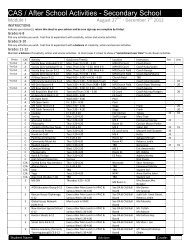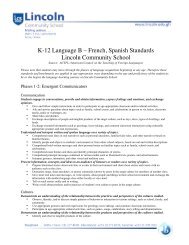MYP Programme Guide - Lincoln Community School
MYP Programme Guide - Lincoln Community School
MYP Programme Guide - Lincoln Community School
Create successful ePaper yourself
Turn your PDF publications into a flip-book with our unique Google optimized e-Paper software.
Page 16<br />
<strong>Lincoln</strong> <strong>Community</strong> <strong>School</strong><br />
Middle Years Program<br />
The Arts:<br />
Music, Drama,<br />
Visual Arts<br />
Course Aims<br />
The aims of the teaching and study of <strong>MYP</strong> arts<br />
are for students to understand how the arts<br />
play a role in developing and expressing personal<br />
and cultural identities, to appreciate how<br />
the arts innovate and communicate across time<br />
and culture, to become informed and reflective<br />
practitioners of the arts and to experience the<br />
process of making art in a variety of situations.<br />
In addition students will explore, express<br />
and communicate ideas, become more effective<br />
learners, inquirers and thinkers, develop<br />
self‐confidence and self‐awareness through art<br />
experiences and appreciate lifelong learning in<br />
and enjoyment of the arts.<br />
Assessment<br />
Students will be assessed against four criteria:<br />
A. Knowledge and Understanding. Students<br />
should be able to demonstrate knowledge<br />
and understanding of the art form studied<br />
in relation to societal, cultural, historical and<br />
personal contexts, demonstrate knowledge<br />
and understanding of the elements of the art<br />
form studied, including specialized language,<br />
concepts and processes and communicate a<br />
critical understanding of the art form studied<br />
in the context of their own artwork.<br />
“In the <strong>MYP</strong>, the arts challenges students to<br />
consider authentic issues and develop their<br />
skills beyond superficiality and imitation.<br />
Students are provided with opportunities to<br />
function as artists, as well as learners of the<br />
arts. To be an artist one has to be curious, and<br />
by developing curiosity about themselves,<br />
others and the world, students become effective<br />
learners, inquirers and creative problem<br />
solvers. In the <strong>MYP</strong>, students are guided to<br />
create, perform and present art in ways that<br />
engage and convey their own feelings, experiences<br />
and ideas.<br />
“In the <strong>MYP</strong>, development in the arts is not<br />
seen as a linear process, and students are<br />
allowed to have varied entry points to their<br />
understanding in the arts, whether through<br />
observation, experimentation, reflection on<br />
existing artwork, practice and development<br />
of techniques, or through the simple need to<br />
express an idea.<br />
“<strong>MYP</strong> arts values the process of creating artwork<br />
as much as the finished product; the two<br />
elements combined tell us what students have<br />
experienced, learned and attempted to convey.<br />
In this way, the educational value of any<br />
artwork is seen by placing it within the context<br />
of its creation.” – <strong>MYP</strong> Arts Subject <strong>Guide</strong><br />
B. Application. The practical application of<br />
the student’s skills to the creation of artwork<br />
will be strongly informed by knowledge and<br />
understanding. The student should investigate<br />
and experiment with his or her artistic<br />
processes through the planning, creation,<br />
performance and presentation of artwork,<br />
developing an initial idea or theme to a point<br />
of realization. These processes should allow the<br />
student to develop and experiment with skills<br />
and techniques, as well as explore, express<br />
and communicate artistic intentions. At the<br />
end of the course, students develop an idea,<br />
theme or personal interpretation to a point<br />
of realization, expressing and communicating<br />
their artistic intentions as well as apply skills,<br />
techniques and processes to create, perform<br />
and/or present art.<br />
C. Reflection and evaluation. This criteria<br />
focuses on the way that a student gradually<br />
comes to feel and think like an artist. Ongoing<br />
reflection should be more than just a record<br />
of what was done. Reflecting critically requires<br />
the student to question and justify the choices<br />
that he or she has made and to develop an<br />
objective evaluation of his or her own work.<br />
The student is encouraged to seek feedback<br />
from others and to consider how this feedback<br />
might inform the work as it develops. At the<br />
end of the course, students should be able to<br />
reflect critically on their own artistic development<br />
and processes at different stages of their<br />
work, evaluate their work and use feedback<br />
to inform their own artistic development and<br />
processes.


